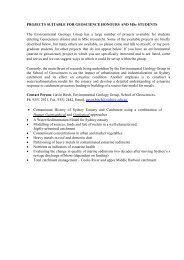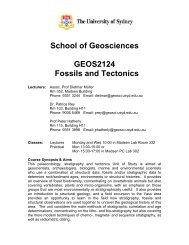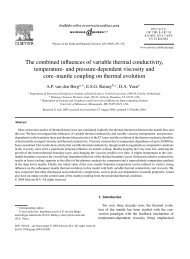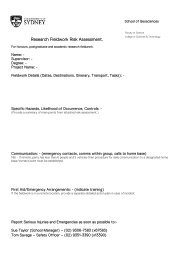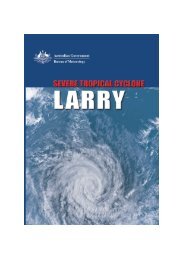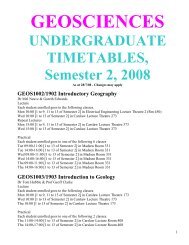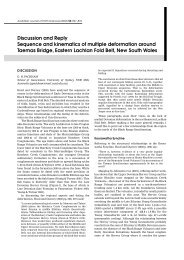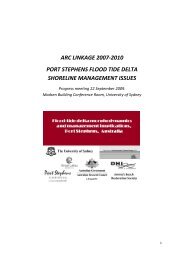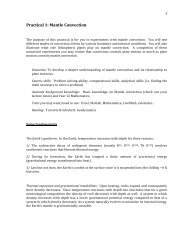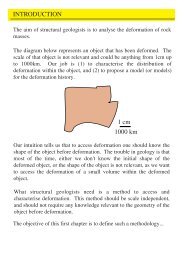Effects of Initial Weakness on Rift Architecture - School of Geosciences
Effects of Initial Weakness on Rift Architecture - School of Geosciences
Effects of Initial Weakness on Rift Architecture - School of Geosciences
You also want an ePaper? Increase the reach of your titles
YUMPU automatically turns print PDFs into web optimized ePapers that Google loves.
Moho temperature <str<strong>on</strong>g>of</str<strong>on</strong>g> 550 ˚C while the 1300 ˚C isotherm is reached at 140km. We<br />
use the standard rheological pr<str<strong>on</strong>g>of</str<strong>on</strong>g>ile <str<strong>on</strong>g>of</str<strong>on</strong>g> Brace and Kohlstedt (1980) for the c<strong>on</strong>tinental<br />
lithosphere in which a Mohr-Coulomb failure law, augmented by a strain weakening<br />
functi<strong>on</strong>, is the dominant failure mechanism at low temperature and high strain rate,<br />
whereas the Frank-Kaminetski approximati<strong>on</strong> (Frank-Kamenetskii, 1955) <str<strong>on</strong>g>of</str<strong>on</strong>g> the<br />
temperature dependent Arrhenius (η) viscosity is used at high temperature and low<br />
strain rate:<br />
! T<br />
( T) e<br />
T 0<br />
="<br />
" Equati<strong>on</strong> (1)<br />
0<br />
where T is the temperature, η 0 is the viscosity at a temperature <str<strong>on</strong>g>of</str<strong>on</strong>g> 0 ˚C and T 0 is a<br />
c<strong>on</strong>stant. Coupling <str<strong>on</strong>g>of</str<strong>on</strong>g> the crust to the mantle is implemented by altering the values <str<strong>on</strong>g>of</str<strong>on</strong>g><br />
η 0 and T 0 . Coupled models have values <str<strong>on</strong>g>of</str<strong>on</strong>g> η 0 and T 0 chosen such that the entire crust<br />
is initially in the brittle regime while decoupled models have values <str<strong>on</strong>g>of</str<strong>on</strong>g> η 0 and T 0<br />
chosen such that the lower crust is initially in the ductile regime (Fig. 1).<br />
Strain weakening in the Mohr-Coulomb failure law is implemented via a power law<br />
functi<strong>on</strong> ƒ(ε)<br />
f<br />
(!<br />
)=<br />
1"<br />
(1 " a)( ! )<br />
!<br />
a<br />
0<br />
!<br />
n<br />
! < !<br />
! " !<br />
0<br />
0<br />
Equati<strong>on</strong> (2)<br />
where ε is the accumulated plastic strain, ε 0 is the saturati<strong>on</strong> strain bey<strong>on</strong>d which no<br />
further weakening takes place, ε n is an exp<strong>on</strong>ent which c<strong>on</strong>trols the shape <str<strong>on</strong>g>of</str<strong>on</strong>g> the<br />
functi<strong>on</strong> and a is a maximum value <str<strong>on</strong>g>of</str<strong>on</strong>g> strain weakening bey<strong>on</strong>d which no further<br />
6




